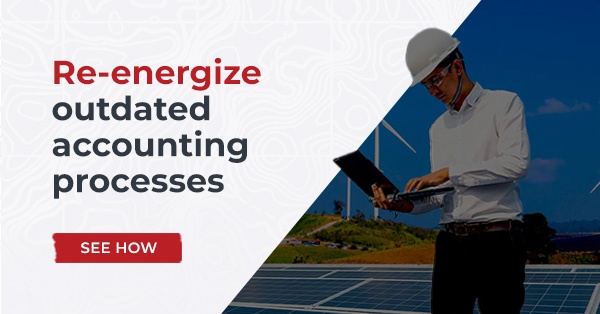10 accounting challenges impacting renewable energy companies

Renewable energy companies have a bright future ahead. Renewable energy capacity increased by 10% last year, according to the International Energy Agency and World Economic Forum, and we're seeing similar increases this year. New ways to share solar power access among communities, integrate clean energy into the electricity grid and improve transmission will continue to drive demand.
For CFOs, controllers, and finance directors responsible for renewable energy accounting, this unprecedented growth brings significant challenges. Growth brings new capital expenses and the need for future investments. It also demands greater efficiency as these companies scale and become increasingly global.
Here are some of the most significant renewable energy accounting challenges on the horizon for fast-growing companies in the United States and globally, and how to overcome them.
Challenges every renewable energy accounting leader faces
1. Calculating depreciation of renewable fixed assets
Renewable energy companies have a large number of fixed assets used to generate power, such as solar panels and wind turbines. Accurately calculating depreciation of these assets may not always be as straightforward as it is with other types of equipment.
One renewable energy accounting challenge lies in keeping up with the complexities of the tax code. While many provisions are favorable to renewable energy, it takes vigilance to remain in compliance with tax laws and maximize investment recovery.
2. Forecasting capital expenses in a rapidly changing energy sector
Renewable energy is rife with innovation. The rise of green hydrogen, advanced batteries and solar-plus-storage buildouts are among Deloitte's near-term predictions for the sector. The firm also anticipates an emphasis on transmission infrastructure development.
While this rapid innovation is exciting from a sustainability perspective, from a renewable energy accounting perspective, it can be difficult to forecast capital expenses in such a fast-paced environment.
3. Capital expenditures vs. repair - getting it right in renewable energy accounting
Once you've invested in fixed assets, you'll need to keep them in working order. Sometimes the line distinguishing maintenance expenses from capital expenditure is obvious; other times it's more blurry. Patching a leaky roof, for example, would be considered maintenance while replacing the whole roof would be a capital expenditure, as it enhances the building and extends its useful life.
The distinction is important from an renewable energy accounting standpoint, as repair costs are deductible business expenses, but capital expenditures must be capitalized and depreciated.
4. Navigating renewable energy equipment lease accounting (GAAP & FASB rules)
If you lease power-generating equipment such as solar panels, General Accepted Accounting Principles (GAAP) recognize two types of leases: operating and capital. Once again, the distinction is significant from an accounting standpoint.
-
An operating lease, according to the Corporate Finance Institute, is an agreement in which the lessee uses an asset for a period of time without assuming ownership. The cost of the lease is considered an operating expense.
-
While previous GAAP required only capital leases to be recognized on balance sheets, new Financial Accounting Standards Board (FASB) requires any asset leased for more than 12 months to be included.
5. Accounting for asset retirement obligations in renewable projects
As early renewable energy installations age, Deloitte expects end-of-life management strategies for renewable energy equipment to be a key consideration in the near future. If you have power-generating equipment such as wind turbines on leased land, you'll need to remove the equipment and restore the land to its owners when the lease expires.
"This should be considered when assessing the life of power generating equipment," cautions PwC. "If costs for the retirement of the equipment are expected to occur, such costs should be accrued and recorded as asset retirement obligation."
6. Disaster recovery and impairment accounting for renewable energy companies
Natural disasters have a much greater impact on renewable energy companies, which rely on fixed assets to generate and distribute power, than many other business types.
Fortunately, when disaster does strike — such as when a tsunami takes out the buoys your company uses to capture power from ocean movement — GAAP has provisions to help recoup some of those losses, namely via impairment. Using impairment, companies can downgrade the value of an asset — and write off the difference — if the book value of the asset exceeds the cash flow and other benefits it's expected to garner.
With severe weather events becoming increasingly common due to climate change, it’s also critical for renewable energy companies to maintain essential business operations. A study by Acronis found 76% of companies experienced downtime, data loss or both due to system crashes, human error, or other causes. Cloud-based software enables faster recovery in the event of a natural disaster because your data is hosted off-site. Cloud providers typically have backup and recovery plans in place to restore functionality as quickly as possible.
7. Multi-entity accounting and consolidating SPEs in renewable energy
According to PwC, renewable energy companies may create special purpose entities (SPEs) when raising funds to finance construction projects or equipment purchases. Often, these are subsidiaries of the parent company. The question becomes whether to consolidate the SPE into the parent company's financial reporting.
PwC urges companies to consider carefully before consolidating SPE's, as voting interests for the company as a whole may not have much control over the SPE. If you decide to consolidate, many legacy accounting software solutions require separate databases, sometimes with separate logins, for each legal entity of an organization. The tedium of logging into and out of multiple databases and repeatedly copying and pasting information may be enough to make you rethink your decision unless you’re using multi-entity accounting software.
8. Accounting for conduits and tax liability in renewable projects
In addition to financing projects and purchases, renewable energy companies may increase their tax efficiency by creating SPEs that own and bear tax liability for the parent company's power-generating equipment.
PwC once again urges caution. With the SPE acting as a conduit for tax liability, the firm says, "it should be carefully considered when assessing impairment and other items that often show a significant difference." That's, of course, in addition to the logistical considerations of multi-entity accounting.
9. Managing multi-currency accounting for global renewable energy operations
We live in a global economy with global supply chains. Many renewable energy companies are now doing business globally in some capacity or another. You may even have or plan to have a branch office or subsidiary in a country other than where your company is headquartered.
This means dealing with multiple currencies and fluctuating exchange rates that accompany them. You may also have to contend with branches and subsidiaries doing business in the local currency while stakeholders expect financial reports in the parent company's functional currency. Without a good system in place, multi-entity accounting can quickly become complicated.
10. Strengthening cybersecurity in renewable energy accounting systems
Cybersecurity breaches are expensive and damage reputations. For energy companies, cyber attacks can be even more destructive than in other industries. Among other possible effects, they can compromise the integrity of information on client and customer payment history, which could lead to erroneous service disconnections.
Because electricity powers equipment such as furnaces, air conditioning units and, in some cases, pumps for well water, more than just convenience is at stake when your accounting software leaves you vulnerable to a cyberattack.
How renewable energy companies can solve these accounting challenges
All of this may sound daunting, but there are ways for finance leaders to mitigate the challenges of the renewable energy sector.
Stay compliant with changing tax credits and depreciation rules
New state and local energy tax credits and favorable asset depreciation calculation methods are coming on the renewable energy scene regularly. Keep abreast of new developments to ensure you're staying compliant and making the most of new opportunities.
Regularly test assets for impairment
While natural disaster is the most obvious cause for asset impairment, it's not the only one. Decreased demand and changes in economic conditions can also cause your company's assets, both fixed and intangible, to lose value. Regularly testing for impairment means you won't be paying excess taxes on overvalued assets.
Invest in cloud-based, multi-entity accounting software
Look for a renewable energy accounting solution with robust security features and the ability to automate manual processes so your team can spend its time identifying opportunities for efficiency and growth instead of being consumed with manual work. Look for an agile, flexible cloud accounting software that will grow with your business and keep your data secure and resilient in the midst of cyberattacks or natural disaster.
Why Gravity Software is the best accounting solution for renewable energy companies
Gravity Software has everything your company needs for efficient renewable energy accounting. It's a multi-entity, multi-currency accounting software so you can easily share data among legal entities and compile separate or consolidated reports as needed. You can transact, operate, and report in different currencies as needed and update exchange rates manually or automatically.
Natively built on the Microsoft Power Platform, Gravity has the benefit of Microsoft’s robust data security, privacy, and resiliency provisions. With Microsoft Power Automate and Power Apps, you can easily create personalized workflows to automate manual processes, streamline approvals and more. Microsoft Power BI makes it easy to gather business intelligence from many sources and visualize it at a glance with charts and graphs.
See what else Gravity can do for your renewable energy company. Schedule a demo today.
Gravity Software
Better. Smarter. Accounting.
Last updated: September 17, 2025



